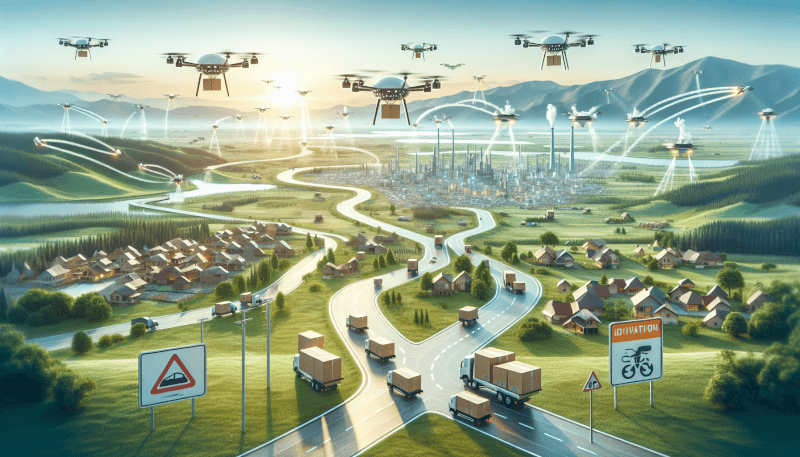In a world where technology is advancing at an unprecedented rate, drone delivery is emerging as a groundbreaking innovation that holds the potential to revolutionize the way goods are transported. This article explores the future of drone delivery, shedding light on the challenges and opportunities that lie ahead. From overcoming regulatory hurdles to ensuring safe and efficient operations, the possibilities for drone delivery are vast. So, fasten your seatbelt and get ready to explore the exciting world of drone delivery in this captivating article.

Challenges of Drone Delivery
Regulatory and Legal Hurdles
One of the significant challenges facing the implementation of drone delivery is the regulatory and legal hurdles. The existing regulatory framework for aviation was not designed to accommodate the unique characteristics of unmanned aerial systems (UAS). Governments around the world are struggling to establish rules that ensure the safe and efficient operation of drones while addressing concerns regarding privacy, security, and airspace management.
Airspace Management
As drone delivery becomes more prevalent, the management of airspace is a critical challenge. Ensuring that drones can safely navigate within a crowded airspace shared by manned aircraft is a complex task. Developing a comprehensive and efficient air traffic control system for drones is essential for preventing mid-air collisions and maintaining the integrity of the airspace.
Safety and Security Concerns
Safety and security are paramount in any mode of transportation, and drone delivery is no exception. The potential risks associated with drones include accidents causing injury or property damage, misuse for illicit activities, and the potential for hacking or disruption of the drone’s control systems. Addressing these concerns and implementing robust safety and security measures are vital for gaining public trust and regulatory approval.
Privacy Issues
Another challenge in the world of drone delivery is addressing privacy concerns. Drones equipped with cameras and sensors have the potential to capture a vast amount of data, raising worries about invasion of privacy. Striking a balance between the use of drones for delivery purposes and protecting individuals’ privacy rights is crucial, requiring clear guidelines and regulations on data collection and usage.
Technological Challenges
Battery Life and Range
One of the most significant technological challenges facing drone delivery is the limited battery life and range. Drones, especially those carrying heavier payloads, are often limited in the distance they can travel before needing to recharge. Extending battery life and increasing range are critical for ensuring the viability of drone delivery on a larger scale.
Weather Conditions
Weather conditions can significantly impact the operation of drones. High winds, heavy rain, snow, or fog can pose challenges in terms of stability, visibility, and maneuverability. Ensuring that drones can operate safely and reliably under a variety of weather conditions is essential for enabling efficient and dependable delivery services.
Payload Capacity
The payload capacity of drones directly affects the size and weight of packages that can be delivered. Increasing payload capacity, while maintaining the performance and safety of the drones, is crucial for meeting the diverse needs of delivery services. Advances in materials technology and design are driving innovations in drone construction to achieve greater payload capacity.
Autonomous Navigation
Autonomous navigation is a key technological challenge in drone delivery. Drones need to be able to navigate complex urban environments, avoiding obstacles such as buildings, trees, and power lines. Developing sophisticated sense-and-avoid systems and incorporating artificial intelligence algorithms for autonomous decision-making are essential for ensuring the safe and efficient navigation of drones in delivery operations.
Infrastructure Requirements
Delivery Hub Network
Establishing a robust and efficient delivery hub network is crucial for the successful implementation of drone delivery. Delivery hubs serve as central points for package aggregation, storage, and routing. Designing an optimized network of delivery hubs that can cater to different geographies and customer demands is essential for achieving efficient last-mile delivery.
Communication Systems
A reliable and secure communication system is essential for the coordination and control of drone delivery operations. Drones need to communicate with each other, ground control systems, and air traffic control to ensure seamless and safe operations. Developing communication systems that can handle the increased traffic and data demands of drone delivery is a critical infrastructure requirement.
Charging Stations
The limited battery life of drones necessitates the availability of charging stations throughout the delivery network. Charging stations need to be strategically located, ensuring that drones can recharge their batteries conveniently and quickly. Investing in the development of efficient and sustainable charging infrastructure is crucial for enabling the continuous operation of drone delivery services.
Package Handling and Routing
Efficient package handling and routing systems are essential for streamlining the logistics of drone delivery. Handling packages of different sizes and shapes, ensuring accurate sorting, and optimizing routes to minimize delivery times are challenges that need to be addressed. Innovations in robotics, artificial intelligence, and machine learning can play a significant role in developing advanced package handling and routing systems.
Public Acceptance and Perception
Perception of Noise Pollution
One of the concerns voiced by the public regarding drone delivery is the potential noise pollution caused by drones flying in residential areas. The perception of drones as noisy, intrusive machines can create resistance to their widespread adoption. Developing quieter drone technologies and implementing noise reduction strategies are vital for addressing this concern and gaining public acceptance.
Concerns about Job Displacement
As drone technology advances, there are concerns about potential job displacement in the delivery industry. With the automation of certain delivery tasks, such as last-mile delivery, the need for human involvement may decrease. It is essential to address these concerns and develop strategies to ensure a smooth transition for affected workers.
Safety Perception
Ensuring the safety of drone operations is critical for gaining public acceptance. The perception of drones as potential hazards can hinder their adoption and regulatory approval. Implementing safety measures, conducting thorough risk assessments, and providing transparent information about safety statistics and incident reporting are crucial for building public trust in drone delivery.

Opportunities in Drone Delivery
Efficient Last-Mile Delivery
Drone delivery offers the opportunity to revolutionize last-mile delivery, addressing the challenges associated with congested road networks and the increasing demand for faster and more convenient delivery options. By bypassing ground traffic and delivering directly to the customer’s doorstep, drones can significantly improve efficiency in the last leg of the delivery process.
Cost Reduction and Time Savings
Drone delivery has the potential to reduce costs and save time for both businesses and customers. By eliminating the need for traditional modes of transportation, such as vans or trucks, the costs associated with fuel, maintenance, and labor can be significantly reduced. Similarly, faster delivery times can lead to increased customer satisfaction and loyalty.
Access to Remote Areas
Drone delivery has the advantage of reaching remote areas that are difficult to access by traditional means of transportation. In rural or geographically challenging regions, drones can provide a cost-effective and efficient solution for delivering essential supplies, medical assistance, and emergency aid.
Environmental Benefits
Drone delivery can contribute to environmental sustainability by reducing carbon emissions associated with traditional delivery methods. By utilizing electric-powered drones and optimizing delivery routes, carbon footprint can be minimized. Additionally, the use of sustainable packaging solutions can further reduce environmental impact.
Innovation in Drone Technology
Improved Battery Technology
Advancements in battery technology are crucial for overcoming the challenge of limited battery life in drone delivery. Longer-lasting and more efficient batteries can extend the range and flight time of drones, improving their overall performance and viability for delivery operations.
Advanced Sense and Avoid Systems
Developing advanced sense-and-avoid systems is essential for ensuring the safe navigation of drones in complex environments. Utilizing technologies such as radar, lidar, and computer vision can enable drones to detect and avoid obstacles, enhancing their ability to navigate autonomously and minimize the risk of accidents.
Swarm Deliveries
Swarm deliveries, where multiple drones collaborate to complete a delivery task, offer the potential for increased efficiency and scalability in drone delivery. By coordinating their movements and tasks, drones can work together to handle larger payloads, optimize routes, and share the workload.
Use of Artificial Intelligence and Machine Learning
The integration of artificial intelligence and machine learning into drone systems can significantly enhance their capabilities. These technologies can facilitate autonomous decision-making, adaptive navigation, and real-time optimization of routing and delivery schedules, improving the overall efficiency and effectiveness of drone delivery.

Collaboration with Regulatory Agencies
Creating Clear and Enforceable Regulations
Collaboration between industry stakeholders and regulatory agencies is crucial for developing clear and enforceable regulations that govern drone delivery operations. Establishing rules that balance safety, privacy, security, and operational requirements are essential for building a regulatory framework that fosters innovation while addressing public concerns.
Developing Standards for Air Traffic Control
Standardizing air traffic control procedures specifically for drones is necessary for the safe integration of drones into the existing airspace. Developing protocols for drone-to-drone communication, collision avoidance, and coordination with manned aircraft can enable efficient and secure operations.
Establishing Safety Protocols
Collaboration with regulatory agencies is vital for establishing safety protocols specific to drone delivery. Setting guidelines for drone maintenance, operational procedures, and incident reporting can ensure high safety standards and enable swift response to any safety issues.
Testing and Certification Processes
Working together with regulatory agencies, industry stakeholders can establish testing and certification processes for drone delivery systems and technologies. This ensures that drones meet specific performance and safety requirements before being deployed in delivery operations, further enhancing public trust in the technology.
Integration with Existing Logistics
Enhancing Supply Chain Efficiency
Integrating drone delivery into existing logistics operations can significantly enhance overall supply chain efficiency. By automating certain delivery tasks and optimizing routes, drones can reduce delivery times, minimize costs, and streamline the movement of goods throughout the supply chain.
Tracking and Transparency
Drone delivery offers the opportunity for enhanced tracking and transparency throughout the delivery process. Real-time information about the status and location of packages can be provided to customers, enabling them to track their deliveries with precision. This level of transparency can improve customer satisfaction and trust in the delivery process.
Inventory Management
Drone delivery can have a positive impact on inventory management. With faster delivery times, businesses can reduce their inventory levels, leading to cost savings and more efficient working capital management. Real-time inventory tracking and automated replenishment processes can further optimize inventory management.
Returns and Reverse Logistics
Drone delivery can also streamline the process of returns and reverse logistics. By offering faster and more convenient returns options, businesses can improve customer satisfaction and loyalty. Drones can efficiently transport returned items, minimizing turnaround time and improving the overall efficiency of the returns process.

Business Opportunities and Market Potential
Delivery Service Providers
Drone delivery presents significant business opportunities for delivery service providers. By adopting drone technology, they can offer faster, more efficient, and cost-effective delivery services, gaining a competitive edge in the market. Established logistics companies and startups alike can tap into this emerging market and diversify their service offerings.
Drone Manufacturers and Developers
The increased demand for drone delivery creates ample opportunities for drone manufacturers and developers. Developing drones specifically designed for delivery operations, incorporating advanced technologies, and ensuring compliance with regulatory requirements can position manufacturers and developers as key players in the industry.
Software and Analytics Companies
The successful implementation of drone delivery relies on robust software and analytics systems. Companies specializing in the development of drone management platforms, route optimization algorithms, and data analytics can provide valuable solutions to enable efficient and secure delivery operations.
Investment and Funding Opportunities
The potential of drone delivery has attracted significant investment and funding opportunities. Venture capital firms, private equity investors, and government funding initiatives are actively supporting the development of drone technology and delivery services. Building partnerships and securing funding can provide the necessary resources to accelerate innovation and scale operations.
Environmental Considerations
Reduced Carbon Emissions
One of the significant environmental benefits of drone delivery is the potential to reduce carbon emissions. By replacing vehicles with drones for last-mile delivery, the reliance on fossil fuels can be minimized, leading to significantly lower carbon emissions and improved air quality in urban areas.
Sustainable Packaging Solutions
Alongside the adoption of drone delivery, there is an opportunity to promote sustainable packaging solutions. Using eco-friendly materials, minimizing packaging waste, and encouraging recycling can reduce environmental impact and promote a more sustainable approach to delivery operations.
Wildlife Protection Measures
Implementing measures to protect wildlife is essential when utilizing drone technology in delivery operations, especially in natural and protected areas. Developing guidelines for drone flight paths and height restrictions can minimize disturbances to wildlife habitats and mitigate potential negative impacts.
Minimizing Land and Infrastructure Usage
Drone delivery has the potential to minimize land and infrastructure usage compared to traditional transportation modes. With the ability to fly over obstacles and access hard-to-reach areas, drones require less physical infrastructure, reducing the need for road expansion or construction. This can lead to a more efficient use of existing resources and minimize land usage.



